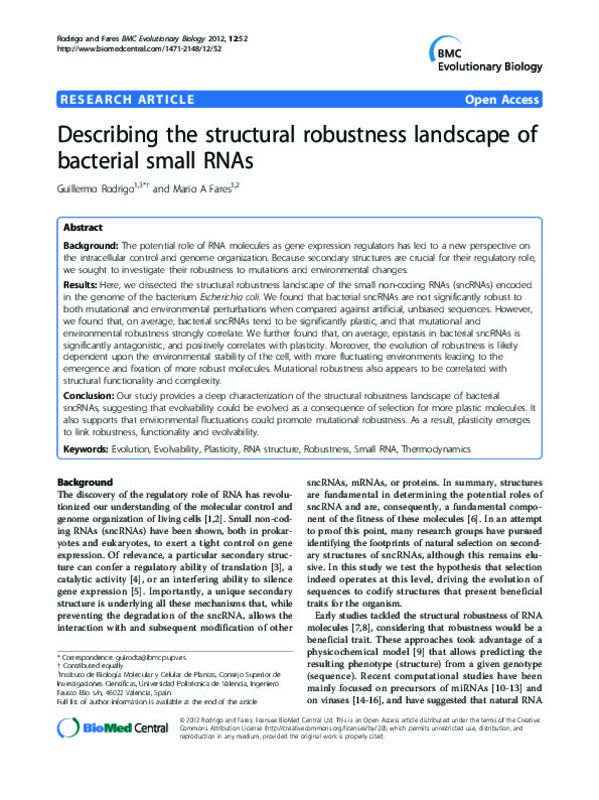JavaScript is disabled for your browser. Some features of this site may not work without it.
Buscar en RiuNet
Listar
Mi cuenta
Estadísticas
Ayuda RiuNet
Admin. UPV
Describing the structural robustness landscape of bacterial small RNAs
Mostrar el registro sencillo del ítem
Ficheros en el ítem
| dc.contributor.author | Rodrigo Tarrega, Guillermo
|
es_ES |
| dc.contributor.author | Fares Riaño, Mario Ali
|
es_ES |
| dc.date.accessioned | 2016-05-12T07:18:09Z | |
| dc.date.available | 2016-05-12T07:18:09Z | |
| dc.date.issued | 2012-04-13 | |
| dc.identifier.issn | 1471-2148 | |
| dc.identifier.uri | http://hdl.handle.net/10251/63944 | |
| dc.description.abstract | Background: The potential role of RNA molecules as gene expression regulators has led to a new perspective on the intracellular control and genome organization. Because secondary structures are crucial for their regulatory role, we sought to investigate their robustness to mutations and environmental changes. Results: Here, we dissected the structural robustness landscape of the small non-coding RNAs (sncRNAs) encoded in the genome of the bacterium Escherichia coli. We found that bacterial sncRNAs are not significantly robust to both mutational and environmental perturbations when compared against artificial, unbiased sequences. However, we found that, on average, bacterial sncRNAs tend to be significantly plastic, and that mutational and environmental robustness strongly correlate. We further found that, on average, epistasis in bacterial sncRNAs is significantly antagonistic, and positively correlates with plasticity. Moreover, the evolution of robustness is likely dependent upon the environmental stability of the cell, with more fluctuating environments leading to the emergence and fixation of more robust molecules. Mutational robustness also appears to be correlated with structural functionality and complexity. Conclusion: Our study provides a deep characterization of the structural robustness landscape of bacterial sncRNAs, suggesting that evolvability could be evolved as a consequence of selection for more plastic molecules. It also supports that environmental fluctuations could promote mutational robustness. As a result, plasticity emerges to link robustness, functionality and evolvability. | es_ES |
| dc.description.sponsorship | We thank S. F. Elena for useful comments. G.R. is supported by an EMBO long-term fellowship co-funded by Marie Curie actions (ALTF-1177-2011). M.A.F. is supported by the Spanish Ministerio de Ciencia e Inovacion grant BFU2009-12022. | en_EN |
| dc.language | Inglés | es_ES |
| dc.publisher | BioMed Central | es_ES |
| dc.relation.ispartof | BMC Evolutionary Biology | es_ES |
| dc.rights | Reconocimiento (by) | es_ES |
| dc.subject | Plasticity | es_ES |
| dc.subject | Evolution | es_ES |
| dc.subject | Evolvability | es_ES |
| dc.subject | RNA structure | es_ES |
| dc.subject | Robustness | es_ES |
| dc.subject | Small RNA | es_ES |
| dc.subject | Thermodynamics | es_ES |
| dc.title | Describing the structural robustness landscape of bacterial small RNAs | es_ES |
| dc.type | Artículo | es_ES |
| dc.identifier.doi | 10.1186/1471-2148-12-52 | |
| dc.relation.projectID | info:eu-repo/grantAgreement/EC/Marie Skłodowska-Curie Actions/ALTF-1177-2011/ | es_ES |
| dc.relation.projectID | info:eu-repo/grantAgreement/MICINN//BFU2009-12022/ES/Impacto De La Duplicacion Genomica En La Innovacion Y Geometria Funcional De Arabidopsis Thaliana/ | es_ES |
| dc.rights.accessRights | Abierto | es_ES |
| dc.contributor.affiliation | Universitat Politècnica de València. Instituto Universitario Mixto de Biología Molecular y Celular de Plantas - Institut Universitari Mixt de Biologia Molecular i Cel·lular de Plantes | es_ES |
| dc.description.bibliographicCitation | Rodrigo Tarrega, G.; Fares Riaño, MA. (2012). Describing the structural robustness landscape of bacterial small RNAs. BMC Evolutionary Biology. 12(52):1-12. https://doi.org/10.1186/1471-2148-12-52 | es_ES |
| dc.description.accrualMethod | S | es_ES |
| dc.relation.publisherversion | http://dx.doi.org/10.1186/1471-2148-12-52 | es_ES |
| dc.description.upvformatpinicio | 1 | es_ES |
| dc.description.upvformatpfin | 12 | es_ES |
| dc.type.version | info:eu-repo/semantics/publishedVersion | es_ES |
| dc.description.volume | 12 | es_ES |
| dc.description.issue | 52 | es_ES |
| dc.relation.senia | 232781 | es_ES |
| dc.identifier.pmid | 22500888 | en_EN |
| dc.identifier.pmcid | PMC3368786 | en_EN |
| dc.contributor.funder | Ministerio de Ciencia e Innovación | es_ES |
| dc.contributor.funder | European Commission | es_ES |
| dc.contributor.funder | European Molecular Biology Organization | es_ES |








